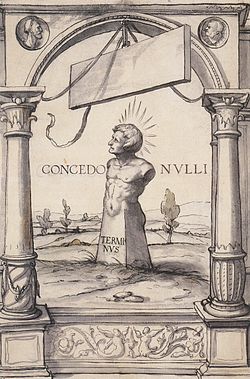
Jupiter, also known as Jove, is the god of the sky and thunder, and king of the gods in ancient Roman religion and mythology. Jupiter was the chief deity of Roman state religion throughout the Republican and Imperial eras, until Christianity became the dominant religion of the Empire. In Roman mythology, he negotiates with Numa Pompilius, the second king of Rome, to establish principles of Roman religion such as offering, or sacrifice.

Vesta is the virgin goddess of the hearth, home, and family in Roman religion. She was rarely depicted in human form, and was more often represented by the fire of her temple in the Forum Romanum. Entry to her temple was permitted only to her priestesses, the Vestal Virgins, who guarded particular sacred objects within, prepared flour and sacred salt for official sacrifices, and tended Vesta's sacred fire at the temple hearth. Their virginity was thought essential to Rome's survival; if found guilty of inchastity, they were buried or entombed alive. As Vesta was considered a guardian of the Roman people, her festival, the Vestalia, was regarded as one of the most important Roman holidays. During the Vestalia privileged matrons walked barefoot through the city to the temple, where they presented food-offerings. Such was Vesta's importance to Roman religion that following the rise of Christianity, hers was one of the last non-Christian cults still active, until it was forcibly disbanded by the Christian emperor Theodosius I in AD 391.
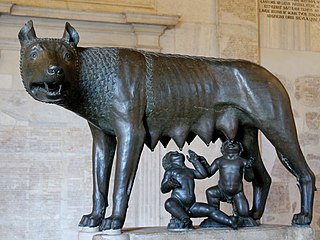
In Roman mythology, Romulus and Remus are twin brothers whose story tells of the events that led to the founding of the city of Rome and the Roman Kingdom by Romulus, following his fratricide of Remus. The image of a she-wolf suckling the twins in their infancy has been a symbol of the city of Rome and the ancient Romans since at least the 3rd century BC. Although the tale takes place before the founding of Rome around 750 BC, the earliest known written account of the myth is from the late 3rd century BC. Possible historical bases for the story, and interpretations of its various local variants, are subjects of ongoing debate.
Juventas, also known as Iuventus or Juventus (Greek equivalent: Hebe), was the ancient Roman goddess whose sphere of tutelage was youth and rejuvenation. She was especially the goddess of young men "new to wearing the toga" (dea novorum togatorum)—that is, those who had just come of age.

Numa Pompilius was the legendary second king of Rome, succeeding Romulus after a one-year interregnum. He was of Sabine origin, and many of Rome's most important religious and political institutions are attributed to him, such as the Roman calendar, Vestal Virgins, the cult of Mars, the cult of Jupiter, the cult of Romulus, and the office of pontifex maximus.
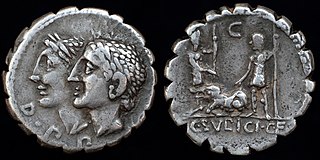
In ancient Roman religion, the Di Penates or Penates were among the dii familiares, or household deities, invoked most often in domestic rituals. When the family had a meal, they threw a bit into the fire on the hearth for the Penates. They were thus associated with Vesta, the Lares, and the Genius of the pater familias in the "little universe" of the domus.

The Sabines were an Italic people who lived in the central Apennine Mountains of the ancient Italian Peninsula, also inhabiting Latium north of the Anio before the founding of Rome.

Juno was an ancient Roman goddess, the protector and special counsellor of the state. She was equated to Hera, queen of the gods in Greek mythology and a goddess of love and marriage. A daughter of Saturn, she was the sister and wife of Jupiter and the mother of Mars, Vulcan, Bellona and Juventas. Like Hera, her sacred animal was the peacock. Her Etruscan counterpart was Uni, and she was said to also watch over the women of Rome. As the patron goddess of Rome and the Roman Empire, Juno was called Regina ("Queen") and was a member of the Capitoline Triad, centered on the Capitoline Hill in Rome, and also including Jupiter, and Minerva, goddess of wisdom.

In ancient Roman religion and mythology, Tellus Mater or Terra Mater is the personification of the Earth. Although Tellus and Terra are hardly distinguishable during the Imperial era, Tellus was the name of the original earth goddess in the religious practices of the Republic or earlier. The scholar Varro (1st century BC) lists Tellus as one of the di selecti, the twenty principal gods of Rome, and one of the twelve agricultural deities. She is regularly associated with Ceres in rituals pertaining to the earth and agricultural fertility.

The Capitoline Triad was a group of three deities who were worshipped in ancient Roman religion in an elaborate temple on Rome's Capitoline Hill. It comprised Jupiter, Juno and Minerva. The triad held a central place in the public religion of Rome.

Egeria was a nymph attributed a legendary role in the early history of Rome as a divine consort and counselor of Numa Pompilius, the second king of Rome, to whom she imparted laws and rituals pertaining to ancient Roman religion. Her name is used as an eponym for a female advisor or counselor.

The Temple of Jupiter Optimus Maximus, also known as the Temple of Jupiter Capitolinus was the most important temple in Ancient Rome, located on the Capitoline Hill. It was surrounded by the Area Capitolina, a precinct where numerous shrines, altars, statues and victory trophies were displayed.
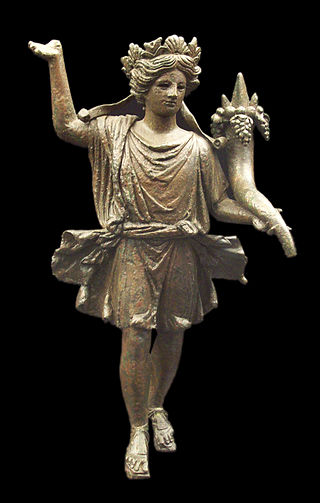
Lares were guardian deities in Sabine and ancient Roman religion. Their origin is uncertain; they may have been hero-ancestors, guardians of the hearth, fields, boundaries, or fruitfulness, or an amalgam of these.

Romulus was the legendary founder and first king of Rome. Various traditions attribute the establishment of many of Rome's oldest legal, political, religious, and social institutions to Romulus and his contemporaries. Although many of these traditions incorporate elements of folklore, and it is not clear to what extent a historical figure underlies the mythical Romulus, the events and institutions ascribed to him were central to the myths surrounding Rome's origins and cultural traditions.

Vulcan is the god of fire including the fire of volcanoes, deserts, metalworking and the forge in Sabine and ancient Roman religion and myth. He is often depicted with a blacksmith's hammer. The Vulcanalia was the annual festival held August 23 in his honor. His Greek counterpart is Hephaestus, the god of fire and smithery. In Etruscan religion, he is identified with Sethlans.

Saturn was a god in ancient Roman religion, and a character in Roman mythology. He was described as a god of time, generation, dissolution, abundance, wealth, agriculture, periodic renewal and liberation. Saturn's mythological reign was depicted as a Golden Age of abundance and peace. After the Roman conquest of Greece, he was conflated with the Greek Titan Cronus. Saturn's consort was his sister Ops, with whom he fathered Jupiter, Neptune, Pluto, Juno, Ceres and Vesta.

In ancient Roman religion and myth, Mars was the god of war and also an agricultural guardian, a combination characteristic of early Rome. He was the son of Jupiter and Juno, and was pre-eminent among the Roman army's military gods. Most of his festivals were held in March, the month named for him, and in October, the months which traditionally began and ended the season for both military campaigning and farming.

In ancient Roman religion, a sacellum is a small shrine. The word is a diminutive from sacrum. The numerous sacella of ancient Rome included both shrines maintained on private properties by families, and public shrines. A sacellum might be square or round.
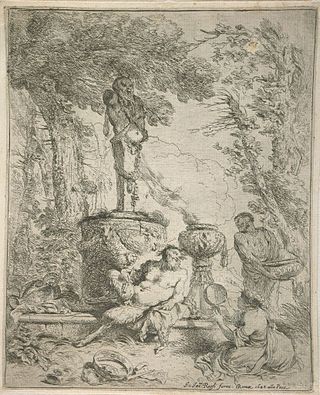
Terminalia was an ancient Roman festival in honour of the god Terminus, who presided over boundaries. His statue was merely a stone or post stuck in the ground to distinguish between properties. His worship is said to have been instituted by Numa who ordered that every one should mark the boundaries of his landed property by stones to be consecrated to Jupiter Terminalis, and at which every year sacrifices were to be offered at the festival of the Terminalia. On the festival the two owners of adjacent property crowned the statue with garlands and raised a crude altar, on which they offered up some corn, honeycombs, and wine, and sacrificed a lamb or a suckling pig. They concluded with singing the praises of the god. The public festival in honour of this god was celebrated at the sixth milestone on the road towards Laurentum doubtless because this was originally the extent of the Roman territory in that direction.
